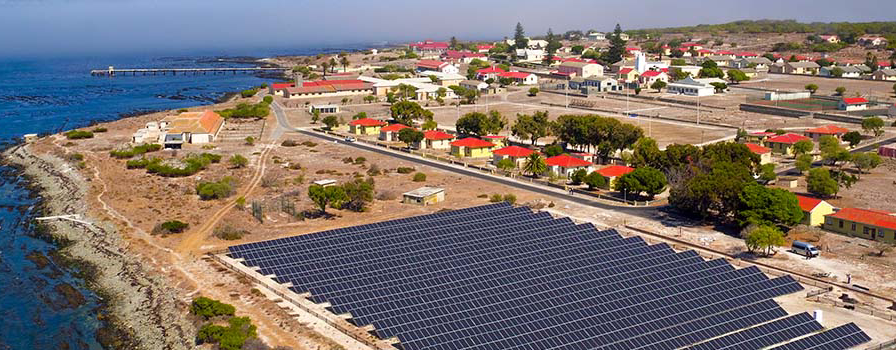5 min read
The grid of the future: How digital technologies are helping solve Africa’s energy challenges

The future is within reach: a robust, clean-energy economy that keeps jobs and money on the African continent. Not only will this economy help prevent damaging pollution from fossil fuels, it will also provide access to electricity, providing a route out of subsistence farming for hundreds of millions of people.
While more than 670 million people in sub-Saharan Africa continue to live without access to electricity, new technologies and the declining cost of renewables can transform the ways they access energy, offering a path to meeting the United Nations Sustainable Development Goal of universal access to affordable electricity by 2030.
ABB is supporting the transformation to a clean energy economy with cutting edge technologies that enable a more reliable, sustainable grid. Around the world, ABB’s Power Grids division is addressing key areas such as the integration of renewable energies, growing network complexity, grid automation and microgrids.
In Johannesburg, the recently completed Sebenza substation, installed to provide greater stability to the power network, is reliably delivering 30 percent additional electricity to help meet increased demand in the growing city. This new facility includes 38 bays of 132 kilovolt (kV) gas-insulated switchgear (GIS) from ABB, making it the largest installation of GIS at this voltage level to be commissioned in Africa. To help better access Africa’s renewable power sources, which are often in remote locations, ABB’s high-voltage direct current (HVDC) transmission system connects electrical grids across long distances with minimal losses. HVDC is ideally suited to integrating distant renewable energy sources, such as remote solar and wind farms, and hydro-electric projects, into the power grid, which will be increasingly important as Africa’s power infrastructure grows.
The Caprivi Link, a 950-km long 350 kV ABB “HVDC Light” transmission system, connects the electricity grids of Namibia and Zambia, enabling power trading over this expansive area. Meanwhile, ABB’s refurbishment of the Songo HVDC converter station in Mozambique enables electricity to be transported 1,417 km from the Cahora Bassa hydro plant to the South African grid.
Cost efficient, sustainable solutions such as microgrids are maximizing the use of renewable energy and ensuring an uninterrupted power supply. This technology integrates renewable energy resources like solar, wind and hydro into the main grid to help keep lights on and factories running, avoiding power outages.
Microgrids are particularly useful in South Africa, where there is the highest electricity consumption in the sub-Saharan region and demand continues to outpace supply. At ABB’s 96,000 square meter Longmeadow facility in Johannesburg, an integrated solar-diesel microgrid ensures uninterrupted power supply and helps to reduce carbon emissions, substantially reducing operational costs.
ABB microgrid and wireless technology has been deployed at Robben Island, enabling the World Heritage Site to run on sustainable, stable solar power – and serve as a global model for the clean-energy future. ABB is also installing microgrid technology at the logistics hub of the International Committee of the Red Cross in Nairobi, so the city’s frequent power outages do not hamper the delivery of food, medicine and other relief supplies across Africa.
Another impressive symbol of the dynamic changes underway in Africa is the Marsabit wind farm in northern Kenya. Featuring ABB’s PowerStore flywheel-based microgrid stabilization, the wind farm is part of Kenya’s plan to quadruple its energy output in the next five years, with the aim of providing the majority of its 50 million citizens access to electricity by 2020.
But while HVDC, microgrids and other transformational technologies that harness the benefits of renewable energy offer solutions to Africa’s electricity problems, the latest United Nations progress report on the Sustainable Development Goals says we are falling short of what is needed to achieve energy access for all.
“Meaningful improvements will require higher levels of financing and bolder policy commitments, together with the willingness of countries to embrace new technologies on a much wider scale,” the report said.
According to the International Energy Agency (IEA), despite worldwide progress in energy efficiency and delivery, 600 million people in sub-Saharan Africa will remain without access to electricity in 2030, unless more investments in grids and these new technologies are made.
The IEA estimates an additional cumulative investment of $370 billion is needed between 2017 and 2030 to meet the energy requirements of the region, an average of $26 billion per year. While a significant sum, it is equivalent to roughly 1.7% of the cumulative investment in the energy sector around the globe over that timeframe.
With more investment, we can all benefit from the transition to a clean energy economy that is taking place around us. Power is becoming cheaper, smarter, cleaner, and more flexible, offering the way out of subsistence farming for hundreds of millions of Africans. The foundations for that energy future are being laid today, and in Africa the setting is perfect to build the optimal architecture from the bottom up. This can indeed be Africa’s “light bulb” moment.